Forum Replies Created
-
AuthorPosts
-
 Bill WardParticipant
Bill WardParticipantHi Andy,
Thanks for the comments. Using a A0 star was exactly what I did to start with. By removing the hydrogen lines this left a nice continuum. But what I found was that at the blue end it produced some odd results because of the shape of the continuum in this regime. In the basic library with Visual Spec the spectrum of Vega, for example has a sharp cut off then some oscillating components. Smoothing this out leads to dips in the continuum which I believe is not reflective of whats going on with a meteor. I could be plain wrong about this of course but I’ve made the assumption that even though a meteor may not have a genuine continuum the spectrum would be superimposed on a hypothetical blackbody continuum of the meteor temperture.
So it might very well be a two step process in the end. Divide through by the si response then do another division with the appropriate black body curve. The plan is to sort out this years Perseid results then go back and try some comparisons with normalised spectra from the ones I’ve collected using both the stellar method and si curve to see how they look.
However this issue isn’t of importance for basic line ID and wavelength calibrations but it’s a necessary step to get a good handle on it for proper flux calibration and measurement. The scientific papers I seen on this seem to me to be VERY complex and need complicated modelling of various parameters. So it’s possible to do but it might take someone with more computing and maths skills than me to crack!
Mmmm, tricky, very tricky but a fascinating challenge! 😉
cheers,
Bill.
 Bill WardParticipant
Bill WardParticipantHi,
Much to my surprise the night of the Perseid peak was clear all night. From22.00ut to 03.20ut I recorded 377 perseids and 51 others/sporadics. Out of these I captured 28 spectra, 8 of which were reasonably good.
One issue that has been problematic is correct “instrument correction” of the spectra. A flux corrected stellar spectrum can be used but what class of star to use? The temperatures that exist with the meteor head are high, several thousand kelvin but using a corresponding temperture of star/black body equivalent means that the shorter wavelength won’t be right. Similalry the reverse is true, correct for short wavelength then the long wavelengths go awry. This is especially a problem as silicon based detectors are hugely more sensitive in the red/near IR than the blue.
I thought it might be interesting to do a instrument correction by dividing through by a nominal silicon photodiode response.
I got a curve from a large photodiode manufacturer and normalised the curve at ~700nm, about halfway between the lowest responsivity and the peak at 820nm. The actual curve varies slightly depending on how the juntion is biased but this mostly affects the longer wavelengths which are being lowered by the division so the errors are small over all (I think 😉 )
Anyway here are a couple of graphs from a spectrum of a Perseid from this years peak. The difference is huge!, they don’t even look like the same spectrum the red has been lowered by that much. This actually shows how INsensitive silicon devices are to the far blue. (film was much better, who’d have thought….)
Uncorrected “raw” spectrum.
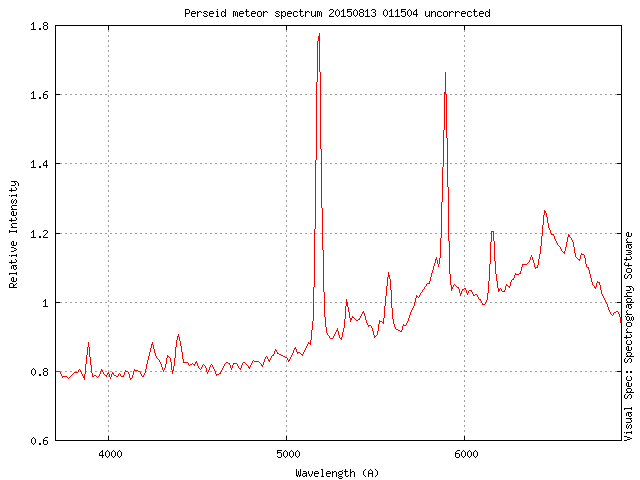
and the “corrected” spectrum
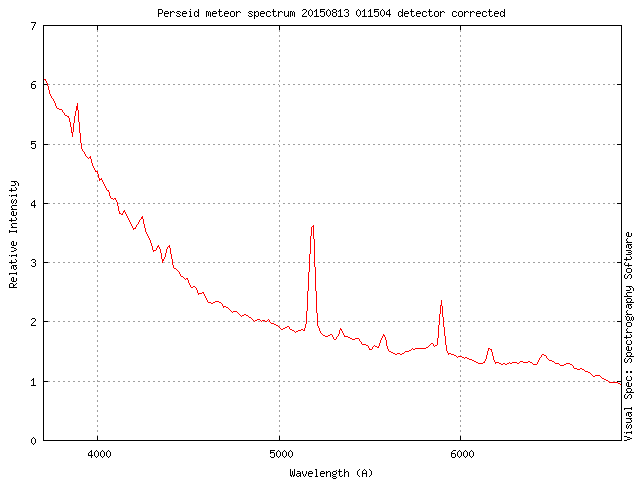
The red end may be a little over done as the original shows a rise in the graph caused by smoke wafting across the fov raising the backgroud level. However the blue end was reasonably dark and is fairly representative. This was the only spectrum of the night that had some blue lines to test the idea on. Its not a perferct example but demonstrates the point.
Having said all that acutal flux calibration is still subject to much uncertainty and is quite difficult to do in an easy manner for us amateurs.
Food for thought….
cheers,
Bill.
 Bill WardParticipant
Bill WardParticipantHi,
Whilst I was a diligent physics student many moons ago I’m afraid my magneto-hydrodynamics at an event horizon is a bit ropy….
However, it is always interesting to see an analogue that demonstrates the physics more clearly than any equation!
Take a look at this story on the BBC News website: http://www.bbc.co.uk/news/world-us-canada-33282343
A great big vortex in a lake being drained to control flooding. What is REALLY interesting is the spontaneous generation of instabilities that propogate UPWARDS out of the vortex throat and against the flow. #4 right at the end is the best! Stretch the plughole analogy to curved space (that is imaging the ring of foamy water being a sphere) and what we might have at V404 is a smilar event. The “flooding” is accrection of new material and the flaring is instabilities of material flashing around the event horizon. I wonder how long before this will appear in a paper somewhere. What do you know!, it happens right here on Earth, just not so violently…… 😉
cheers,
Bill.
 Bill WardParticipant
Bill WardParticipant….And another….
A really well dispersed spectrum of a sporadic meteor captured on the night of the Lyrid shower peak.
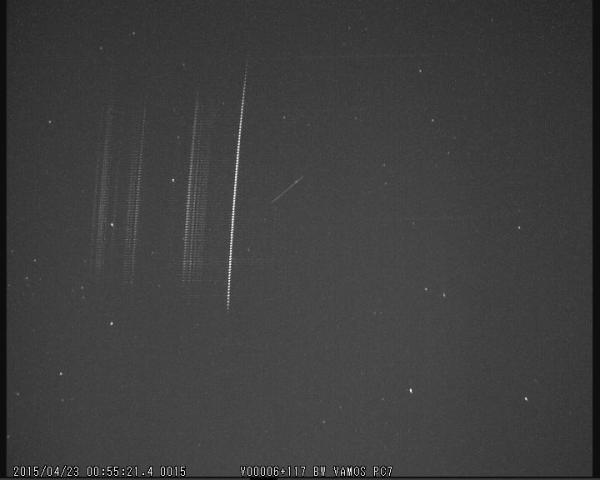
The instrument corrected graph.
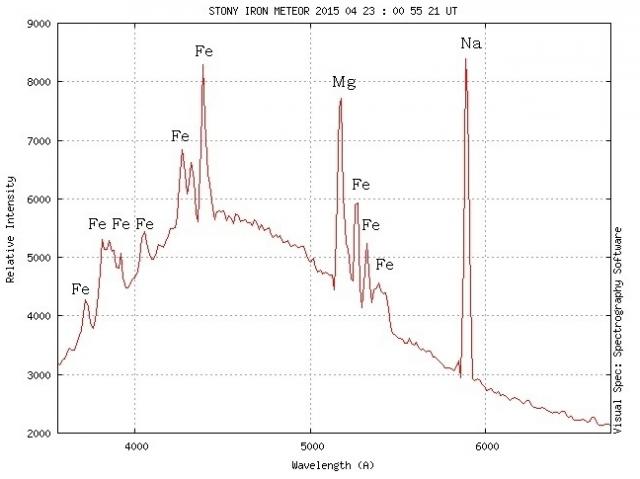
And of course the celestial art which just looks better….

cheers,
Bill.
 Bill WardParticipant
Bill WardParticipantHi,
Another interesting spectrum to consider. I caught an usual spectrum on the morning of the 13th. Unusually it only had one bright line in the green. I initially assumed this would be magnesium. WRONG! The alarm was raised when the atmospheric lines (to the right hand side of the spectra) didn’t fit. After trying a few lines from the NIST reference library the best candidate was from iron. Re calibrating using the atmospheric oxygen line, the green line did seem to fit with an iron emission. So did the blue iron and calcium lines. So I’m confident this is a reasonable fit.
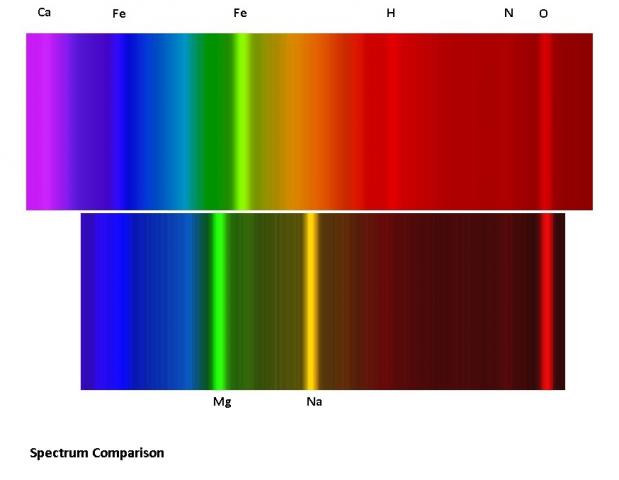
I’ve compared it to the spectro-orbital capture from the 4th to show the differences. The one from the 4th looks like a stony/stony iron with the rich Fe, Mg and Na lines. What this one is I don’t know.
Yet another one for the zoo….
cheers,
Bill.
 Bill WardParticipant
Bill WardParticipantAfter some quick work by William, the orbit indicates a low inclination sporadic.
Bill.
 Bill WardParticipant
Bill WardParticipantHi,
After a bit of messing around I managed to produce this sky track for the meteor in UFO Analyser. William will be doing the orbital analysis of myself and Dave’s data (as well as hopefully Dennis’s)
It seems that this might well be a Lyrid. However once the orbit has been determined we should have a better idea of the certainty of that.
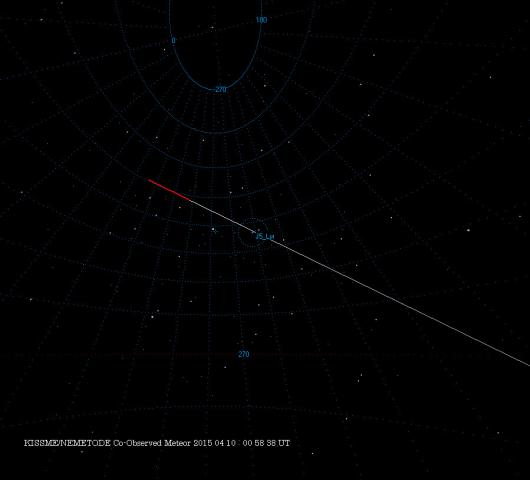
(To his credit he came up with the highly imaginative name/acronym for my spectroscopy programme. Much better than what I had originally thought :-)))
Looking good.
Cheers,
Bill.
 Bill WardParticipant
Bill WardParticipantHi,
A first (as far as I know) for UK meteor observing early this morning. Working with some of the Nemetode group I finally caught a meteor that was also captured with the Nemetode observers’ camera (David, just outside Girvan). This is a great step forward as it means we can now have orbital AND compositional information for meteors.
Here is my capture frame:
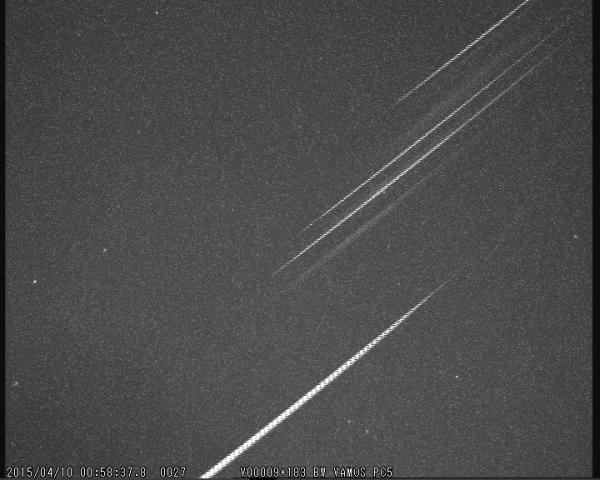
And here is Davids image:
Doing the usual spectrum processing reveals very strong Magnesium and Sodium emmisions but there are also bands of iron in the spectrum. So it looks like this was a stony iron meteor, thus:
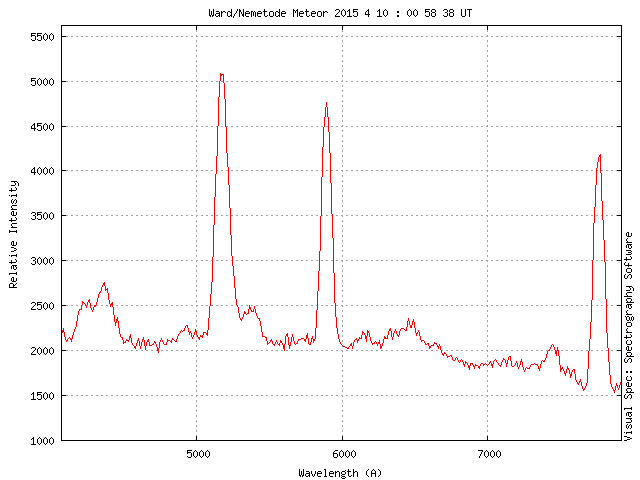
and the usual colour treatment:

There is the possibilty that it was caught from another location which would give a much better orbital fit. Hopefully Dennis will have re positioned his camera.
It’s all good stuff :-))
cheers.
Bill.
 Bill WardParticipant
Bill WardParticipantHi,
I think this is quite an interesting little spectrum. 0508UT 15/3/15. Not very bright and very few lines visble. However it has exceptionally bright OI emission from the “forbidden” transision at 557.7nm. Looking at any other of my spectra here there is no comparable emission in any of them!

Due to the quantum mechanics involved this is a meta stable state, the O atoms sit excited for 0.74 seconds before emitting the photon. So it only occurs with meteors that are very swift and start to or completely abalate above ~100-110km. Below this the atmosphere quenches the transition through collisional loss.
The usual strong Mg and Na so looks like a stony job but it must have been coming straight at us for a very fast effective impact speed. A fascinating addition to the diagnostic info available.
cheers,
Bill.
 Bill WardParticipant
Bill WardParticipantHi,
Thanks, that is very useful to know. The velocity of the meteor appears significantly greater than what was expected for either a daD or Qua.
Cheers,
Bill.
 Bill WardParticipant
Bill WardParticipantHi William,
Thanks for the offer, I had to dig out my old manual and notes, and nearly called as I was tearing my hair out a one point but I think I’ve got it sorted out.
Analyser classifys it as a sporadic! (it classes the spectrum as a ” -6 flash”). I don’t know how reliable it ultimately is, only a handful of reference stars.
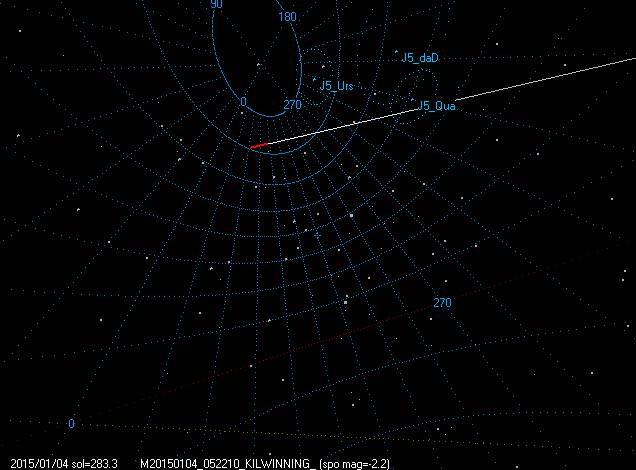
So, there’s at least the possibility that previous professional work might have been based on erroneous assumptions.
Score one for the amateur 🙂
I suppose the next thing to do is to have a look at the Quadrantids parent body. In a previous post I said “sodium deficiency” but that should have been “sodium defficiency with respect to magnesium” as there is no prior knowledge that the material isn’t just like that! The issue with the gemininds is that the sodium has been some how lost due to its orbit and low perihelion distance.
Of course it could all be a lot of nonsense! 😉
cheers,
Bill.
 Bill WardParticipant
Bill WardParticipantHi Alex,
I’ve tried it with the mobile rig but the problem I found is it stronly depends on the lens/grating/sky conditions.
I’m not quite sure why there are differences between what are osetensibly the same set ups but some of the gratings seem to be a lot more transparent than others (across the 600 g/mm ones.) and varies the reference stars, if any, that can be seen. That’s the problem. However, I never thought to try the 300g/mm which shows more stars. I caught “Q1” on that too. I’m not sure how it will handle the “width” of the spectrum though. Can you manually indicate start and end points? Then I could select a single line.
It interesting you mention the Geminids. Although I only got one spectrum from that shower despite vastly more meteors, it showed the expected result. That is a sodium deficiency however with the results here I think it can be safely concluded that the quadrantids (or a subset thereof) are sodium deficient too. That might be in the professional literature but I’ve never heard of it. Need to check.
Cheers,
Bill.
 Bill WardParticipant
Bill WardParticipantYep, The operational problems caused by moonlight preclude permenant orientation so Analyser not useable which is a pain in the neck.
The following spectrum was derived from an image taken by the Japanese observer Koji Maeda.
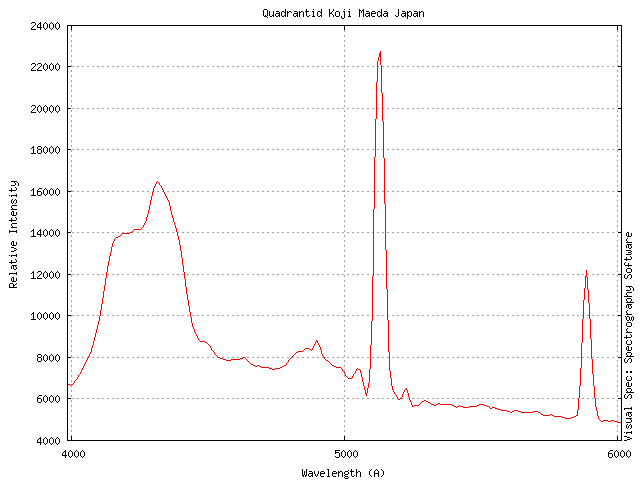

I don’t think there can be any more doubt that these spectra reveal there is a particular composition to some Quadrantids. It’s a whole other ball game to consider what might cause the difference (assuming the first spectrum IS of a Quadrantid).
cheers,
Bill.
 Bill WardParticipant
Bill WardParticipantThis is the composite video of the early part of the meteor (Q1). Does this look like it’s coming from a bit off radiant?
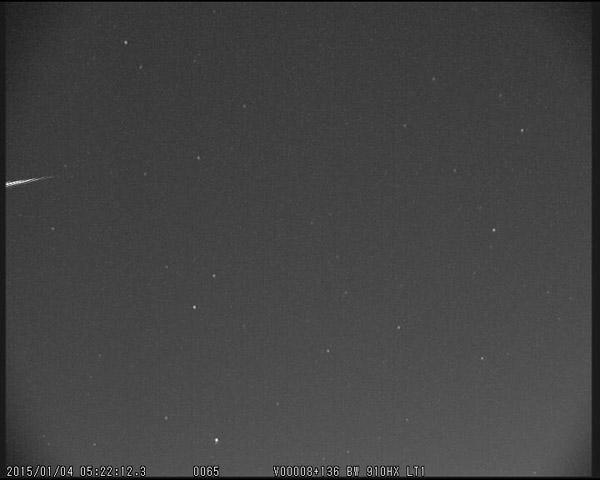
What say ye?
I’ve tried other separate video lines and they mostly have more sodium than magnesium. So the binning can be fooled by the interline gaps on images that are not re-oriented perfectly vertically over the whole spectrum in question.
I’ve seen another image from Japan. It only shows limited lines but if the dispersion is as I think then the magnesium line is much stronger than the sodium line. Just like the other three here. The celestial pidgeons might be getting nervous…
cheers,
Bill.
 Bill WardParticipant
Bill WardParticipanttest
 Bill WardParticipant
Bill WardParticipantHi William,
I genuinely cannot believe what is possible now, even a year ago I never imagined I’d be getting such results. The group in the 2005 paper were using image intensifiers and other bits of technology. Now it’s just straight out of the box!
Alex made the point well, once we finally get some mutual orbital data for a good sample size we’re into new territory.
I’ve had no feedback from the “Lens man” yet but if I get a couple of these fast lenses I’ll have sufficient to kit out all the cameras with a fast lens and decent grating. Computing problems are the next issue to be addressed. Need to have a chat with my IT guru’s.With a couple of teasers last year I’m planning on have two south point cameras this year during the Lyrids. weather permitting. The moons situation is good so that’s the plan.
cheers,
Bill.
 Bill WardParticipant
Bill WardParticipantWell, well, well…
A rough and ready re-do of a SINGLE frame reveals:
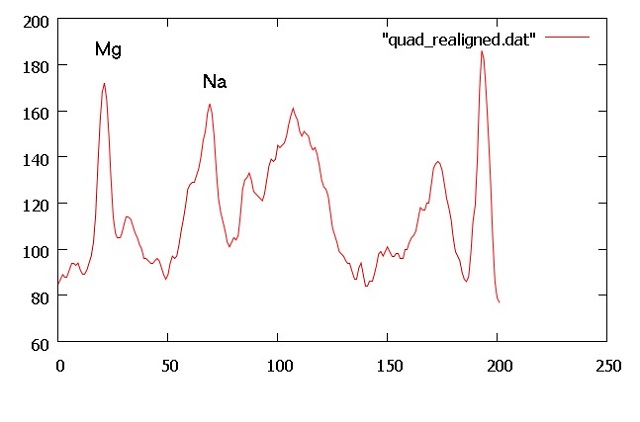
The Magnesium line does indeed squeak up a bit! There’s definitely dodgy dealings going on with the binning but I don’t know if this is enough to swing the issue.
It’s all good fun and I’m off for a cuppa….
 Bill WardParticipant
Bill WardParticipantIn an effort to try and find out more about Quadrantid spectra I did a “google”. One paper appeared a few times. Titled “First Results of Quadrantid Meteor Spectrum” by Shinsuke Abe et al. The paper is here: Lunar and Planetary Science XXXVI (2005), PDF 1536.
The text says they analyzed 4 sets of data (mmm there’s another coincidence…). What is truly spooky is the image shown on the summary page is this (which I cut from the document)
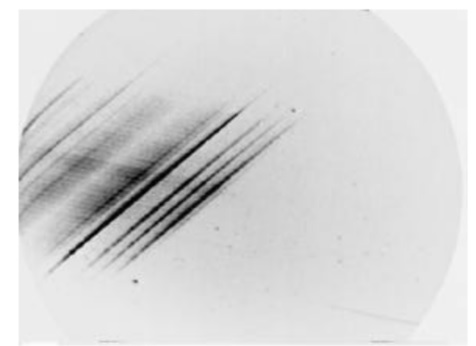
Now I have re-aligned and inverted the grey scale on my own image so that an easier comparison can be made, thus:
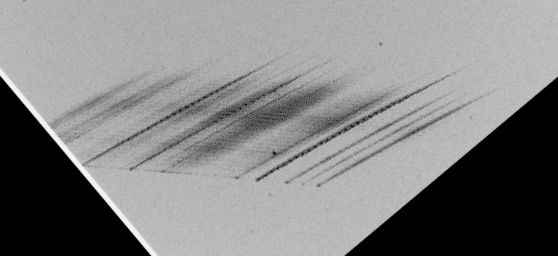
They are almost identical!
I will need to re-process Q1 in case there is some binning issue or other geometrical effect I’m missed. If the magnesium lines still comes out weaker than the sodium line then that’s a cosmic cat amongst the celestial pidgeons. If it corrects then bigger meteoroids produce more intense emissions. (Perhaps that’s even common sense.) The differences in spectra may then be a function of the way a given mass ablates.
Proper science guv!
cheers,
Bill.
 Bill WardParticipant
Bill WardParticipantHi,
Just another thought. Have we ever been in this situation before? By that I mean has there been any other time when so much detailed data has been available for consideration these sorts of questions can even be asked? Rather than just a numbers game we can now get right down to the orbits and composition of the meteorids.
Bodes well for meteor astronomy I think!
Cheers,
Bill.
 Bill WardParticipant
Bill WardParticipantHi Alex,
The radiants are quite close. I’ve had another look at the various videos. I’ve only got the tail of Q1 in the wide field. But I caught it on two of the spectro systems. (a 300 g/mm and a 600g/mm) I’m tempted to say it “looks” a touch faster than the others.
Q1 looks very like the fireball spectrum in the other thread. In Q2, Q3 and Q4 the only really prominent atmospheric line is at 777.4nm, the others from O and N are very weak unlike Q1. Since these are taken to be atmospheric this might suggest a less “energetic” entry as, that is perhaps a lower velocity for the 3.
Maybe its a case of just actually believing what we see. Q1 looks significantly different to Q2, Q3 and Q4 so it probably is. Whether it is indeed a sporadic imposter or a daD, that’s another question!
Oh well if it’s not a Quadrantid, and maybe not even a daD then my tweets were all nonsense (but nothing new there then)
It better be clear next year so I can check!
Cheers,
Bill.
-
AuthorPosts
